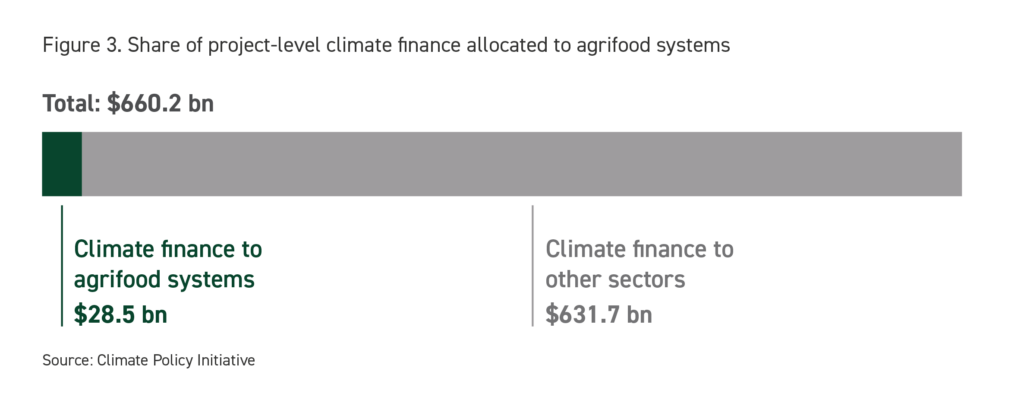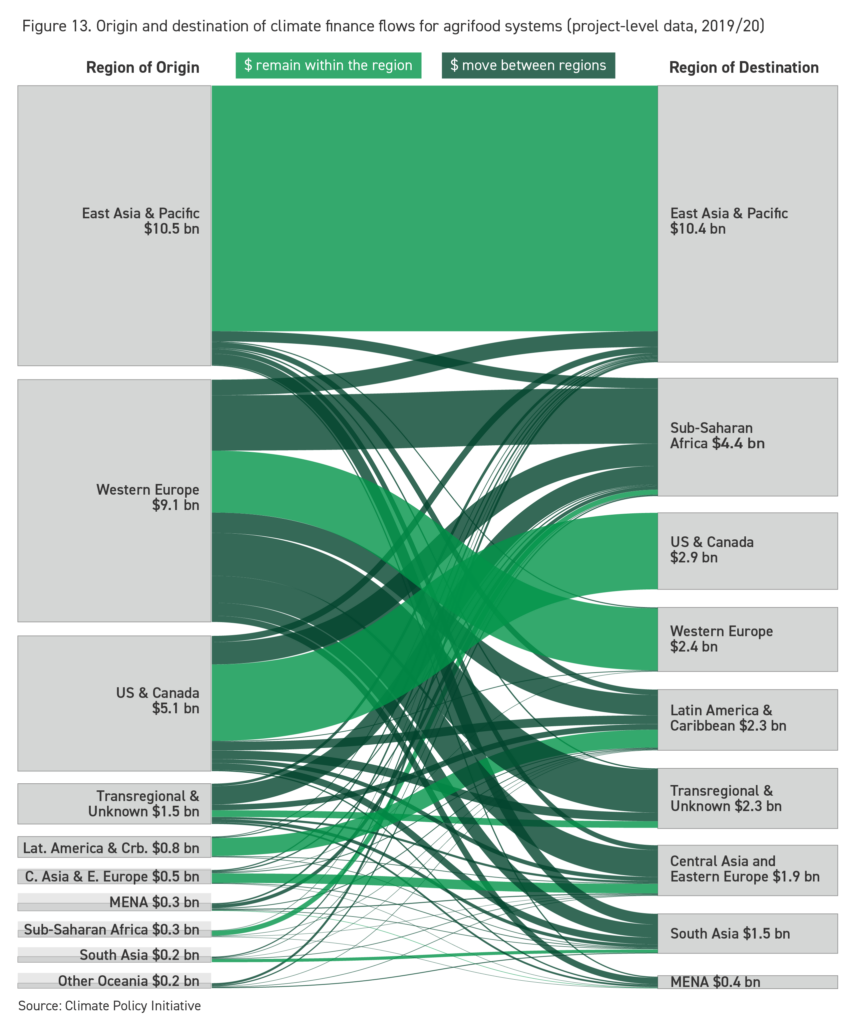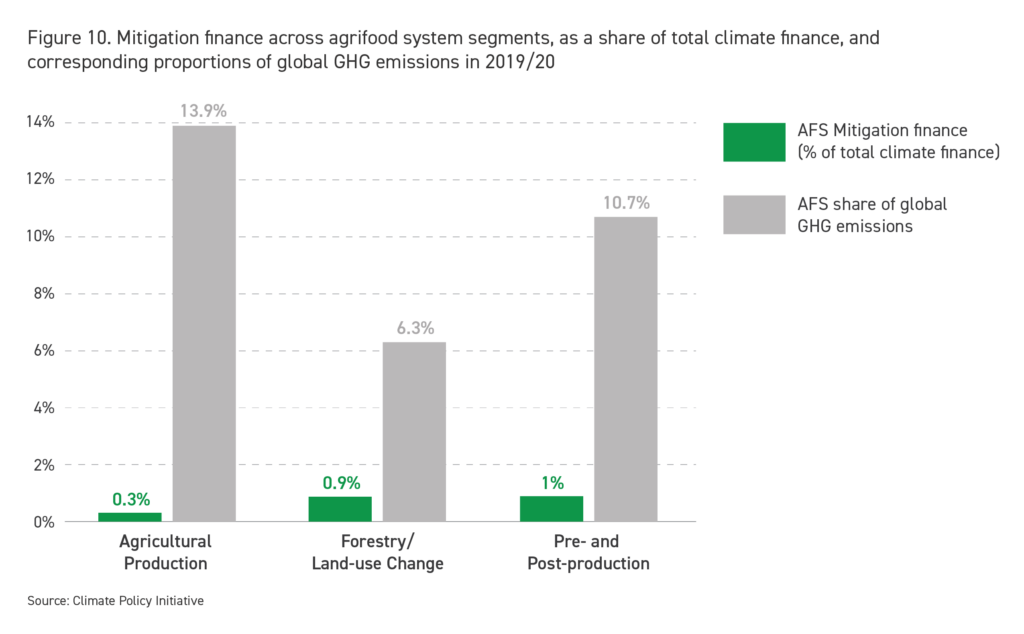Climate Finance Gap: Only 4% of Global Funding Goes to Agrifood Systems, Says New Report
5 Mins Read
Only a minuscule 4.3% of all global climate investment goes to agrifood systems, which are responsible for nearly a third of all greenhouse gas emissions – revealing a “vast and critical” climate finance gap, states a new report. And components that are crucial for climate mitigation – food loss, waste and low-carbon diets – receive less than 1% of all climate funding.
The Climate Policy Initiative (CPI) report states that agrifood systems are “increasingly vulnerable to climate change, threatening food security and price stability”, while low-carbon and resilient systems are essential to ensuring food security and supporting economic development. The climate finance received by this industry, which includes high-emitting and climate-vulnerable sectors, is “strikingly low”, according to the report authors.
As of 2019-20, agrifood systems only received an average of $28.5B per year, with the CPI estimating they need at least seven times more ($212B) annually to be on course to meet the “most conservative estimate” of the Paris Agreement’s targets. In the same period, only 20% of venture capitalist (VC) funding in agrifood tech went to businesses that focus on climate solutions – an average of $4.8B.
The bulk of the financing received by these systems goes to agriculture (42%) and forestry activities (41%). While the former needs roughly two to 16 times more and the latter five to 64 times more than current financing, the minimum gap is even wider when it comes to investment in food loss/waste and low-carbon diets. Here, only $100M is funded at project level and $1.1B at company level (about half of total financing at this level) – over 40 times less than the estimated annual requirement of $48-50B.

Geographic discrepancies
Over a third of climate financing in agrifood systems (about $10.4B) goes to East Asia and the Pacific region, with a large portion of domestic funding in China. This is followed by Sub-Saharan Africa at $4.4B (16%), and the US and Canada at $2.9B (10%).
South Asia (5%) and Latin America and the Caribbean (8%) are underserved by climate agrifood finance when compared to their contributions to GHG emissions (10% and 16%, respectively). Meanwhile, Sub-Saharan Africa and South Asia are the regions with the greatest climate vulnerability for food and agriculture production, but only receive 16% and 5% of climate investments, respectively.
Most of East Asia and Pacific’s funding remains in the region, while all investments in the US and Canada come from domestic sources. Western Europe is similar, with only a tiny amount of financing coming from the two regions above. The US and Canada are also the destination markets for 65% of the VC investments ($4.8B in total), with Western Europe the second-largest recipient at 15%. In contrast, India – one of the world’s largest agrifood tech markets – only received 2% of VC climate funding, signalling an opportunity to tap into other markets.

Finance based on climate objectives
The two types of climate financing the report tracks are mitigation and adaptation funding. Mitigation-focused agrifood systems saw an injection of $14.4B at project level – 2% of the total climate finance across all sectors, despite their contribution to global GHG emissions (about a third). At company level (VC), two-thirds of all agrifood finance (about $3B) was mitigation-focused.
In terms of adaptation finance, project-level funding for agrifood systems reached $7.3B, which amounts to 1.1% of all climate investments across sectors, despite these systems and farmers being highly vulnerable to climate risks. And only 26% of VC investments went to adaptation-focused agrifood tech startups ($1.27B).
The remaining $6.7B (23%) of project-level and $270M (12%) of company-level climate finance for agrifood systems went to those with dual mitigation and adaptation objectives. CPI says this represents a missed opportunity, “considering that agrifood systems are uniquely positioned to deliver double wins by using climate-smart agriculture integrative approaches”.

Media coverage and consumer knowledge gap
This gap in climate finance and agrifood systems could be explained by the systemic underreporting of animal agriculture in climate change media coverage. A study by Faunalytics and Sentient Media found that 93% of reports about climate change did not discuss animal agriculture – and those that did rarely touched upon its impact on the environment.
The analysis also found that animal agriculture is often portrayed as a victim – rather than a significant cause – of climate change. Meat and dairy production has been estimated to account for between 11.1% to 19.6% of total GHG emissions. This disconnect also extends to a knowledge gap in the global population.
According to a global poll by Northstar Research, industrial meat ranks 11th on the list of what respondents feel are the biggest contributors to climate warming – revealing a “chasm between scientific evidence and public perception”. Similarly, a Newsweek poll found that 40% of Americans don’t believe eating less red meat would lower carbon emissions. But beef and lamb have been found to be the highest GHG-emitting food groups.
The CPI study says that there’s enough liquidity to finance the transition to agrifood systems globally. According to the World Bank, global public subsidies for agriculture and fisheries amount to $670B, most of which support harmful practices. CPI suggests that repurposing these flows to facilitate climate interventions could boost the levels of climate finance.
This research also chimes with PwC’s State of Climate Tech 2022 report, which found a disproportionate link between the funds and GHG emissions. According to PwC, the mobility sector is responsible for 15% of global emissions, but at 48%, receives almost half of all climate financing. Food and agriculture, on the other hand, make up 22% of the planet’s total emissions, but are only subject to 12% of funding.
The financial, media and knowledge gap when it comes to the link between climate change and food is significant – and it needs to be plugged before it’s too late.
This story was updated on February 8, 2024 to update reflected VC figures from the Climate Policy Initiative.



